
|
|
|

|
Coin #21:
Sasano-Hunnic Kingdom in Sindh, Varahran V ?, gold dinar, c. 6th century CE
Bust of king right, holding something to his nose, stylized sri in right field /
Fire altar flanked by armed attendants
Weight: 7.14 gm., Diam: 17 mm.
Ref: previously unpublished |
|
The Huns eventually made their way all the way to the Arabian Sea. Coin 21 is a Sasanian style gold issue of a Hun tribe in Sindh, the southern province of modern
Pakistan whose capital is Karachi. This type follows some very rare types issued by the Sasanian governors of Sind in the fifth century, showing a bust of the king
right on the obverse and a stylized fire altar on the reverse. This coin, which I believe is unique, has a remarkable variation. It shows the king holding to his nose
something pinched between his thumb and index finger! A feature of the Hunnic coins from Sindh, seen also on this coin, is the presence of a stylized letter Sri in front
of the king's face. We do not know who issued this coin; the king's crown resembles the crown of the Sasanian emperor Varahran V (420-438 CE), which allows us
to fix an approximate date for the coin.
To see the approximate geographical location of where this coin was issued, look for letter E on the map.
|
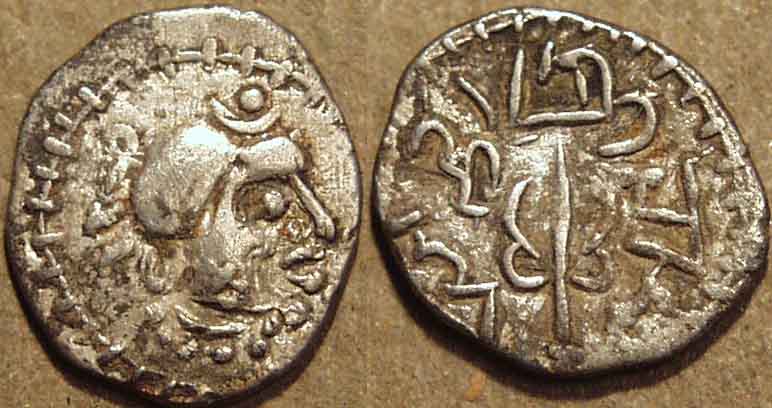
|
Coin #22:
Late or post-Hunnic Kingdom in Sindh or Punjab, Prachandendra, silver unit,
c. 6th or 7th century CE
Head of king right, wearing sun and moon crown /
Trident surrounded by Brāhmī legend: sri prachandendra
Weight: 0.57 gm., Diam: 10-11 mm.
Ref: Tandon, JONS 197 |
|
Coin 22 is a very obscure coin type that I discovered in 2008. It likely came from a small hoard of silver coins discovered in Sindh a few years ago and names a king
previously unknown: Sri Prachandendra, whose name means "mighty king" or "mighty Indra." The style of the coin and of the letter forms suggests it is a late Hunnic
or post-Hunnic coin of the late 6th or early 7th century. The coin points very clearly to the way in which India served as a melting pot. If the coin is Hunnic, it shows
how Indianized these Huns had become, with a Sanskrit name, a Shaivite trident on the reverse and the use of Brahmi letters for the legend. If it is non-Hunnic, it
betrays its descent from Hunnic coin types, with the bust of the king, the sun and moon "crown" and the Brahmi legend preceded by the word Sri.
The rulers of this dynasty seemed to have names associated with the sun, and so it is tempting to hypothesize that the coins were issued in Multan, which had a
famous sun temple. To see the approximate geographical location of where this coin was issued, look for letter E on this
map. |

|
Coin #23:
Kidarites of Kashmir, Toramana II, AE dinar, c. 7th century CE
Stylized king standing facing, sacrificing at altar at left /
Goddess enthroned facing, holding lotus flower and diadem
Brahmi legend at right: jaya
Weight: 7.04 gm., Diam: 21 mm.
Ref: Mitchiner Non-Islamic 151-154 |
|
Coin 23 illustrates the same phenomenon (of the combination of Hunnic and Indian influences) on a Hunnic coin from Kashmir. The Kidarites were a Hunnic tribe
who contributed to the decline of Kushan power by seizing the northern parts of their kingdom in the 4th century. Although the major center of Kidarite power itself
came under attack and was broken up, small offshoot Kidarite tribes retained power in different regions of northern India for several centuries. One such offshoot is
now called the Kidarites of Kashmir, who gave rise to a kingdom that persisted in various forms for approximately 700 years. The coinage of this region followed from
the late Kushan type of the 4th century, with a standing king sacrificing at a fire altar on the obverse, and a seated Ardochsho/Lakshmi on the reverse. On this coin,
for example, it is clear that the deity on the reverse has become Lakshmi, as what used to be a cornucopia in her left arm has here become a long-stemmed lotus
flower. We also see the Sanskrit word Jaya, or "victory," in Brahmi letters in the reverse right field.
To see the approximate geographical location of where this coin was issued, look for the number 23 on this map. To see the
original Kushan style gold coins on which this type was based, look at the coins of Gadahara.
|
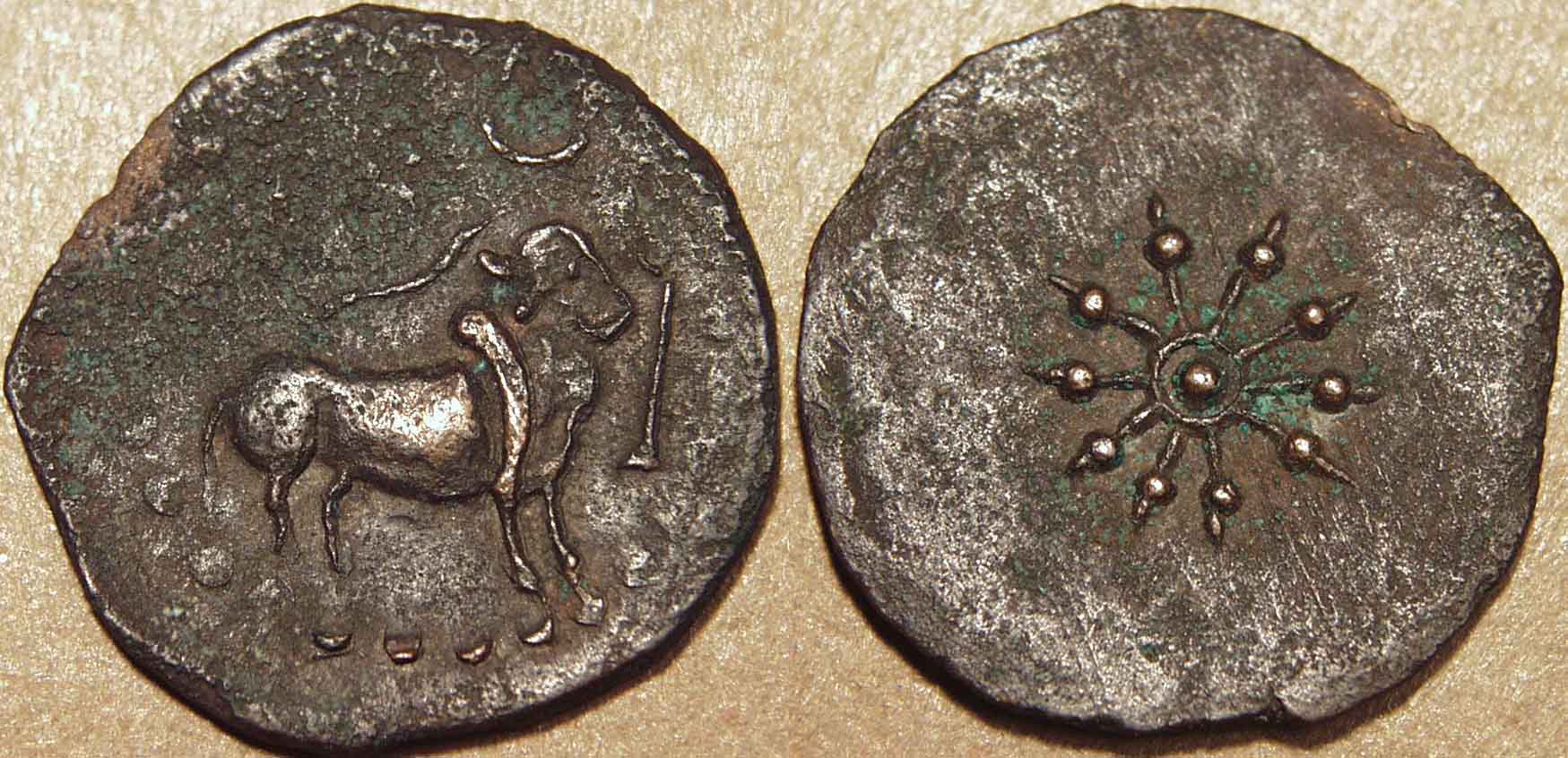
|
Coin #24:
Pallavas of Kanchi, Potin unit, c. 642-655 CE
Pallava bull standing right, surrounded by sacred symbols /
Sunburst
Weight: 3.78 gm., Diam: 22 mm.
Ref: Mitchiner Tamil Nadu Kerala 261-262 |
|
The last eleven coins have all been from northern India. This
is partly because I personally am most interested in this time and region and have collected these coins most actively. The coins from northern India of this period
cover some of the most beautiful coinages of the country, including the Kushans and the Guptas. But another factor for these choices is that southern India was
going through a relatively "dark" phase, during which southern kingdoms were engaged in almost continuous warfare and much of the southern economy was not
monetized. Very few coins were being issued in the south during this period.
One of the dynasties which had persisted during the centuries was that of the Pallavas. The earliest records of the Pallavas date to the 3rd century, and the dynasty
ruled much of what is now Andhra Pradesh and northern Tamilnadu until the 9th century. During this period, they produced a small coinage of lead and potin coins,
at least judging by the scarcity of the coins today. The illustrated coin is a rare issue of the Pallava king Narasimhavarman I (c. 630-668), thought to have been
issued in Badami, the capital of the Chalukya empire. Narasimhavarman briefly held Badami during one of the continual wars the Pallavas and Chalukyas fought
through much of this period. The coin shows the bull Nandi, the dynastic symbol of the Pallavas, which is present on almost all known Pallava coins, along with other
symbols on the obverse, and a sunburst on the reverse.
To see the approximate geographical location of where this coin was issued, look for the letter F on this map.
|
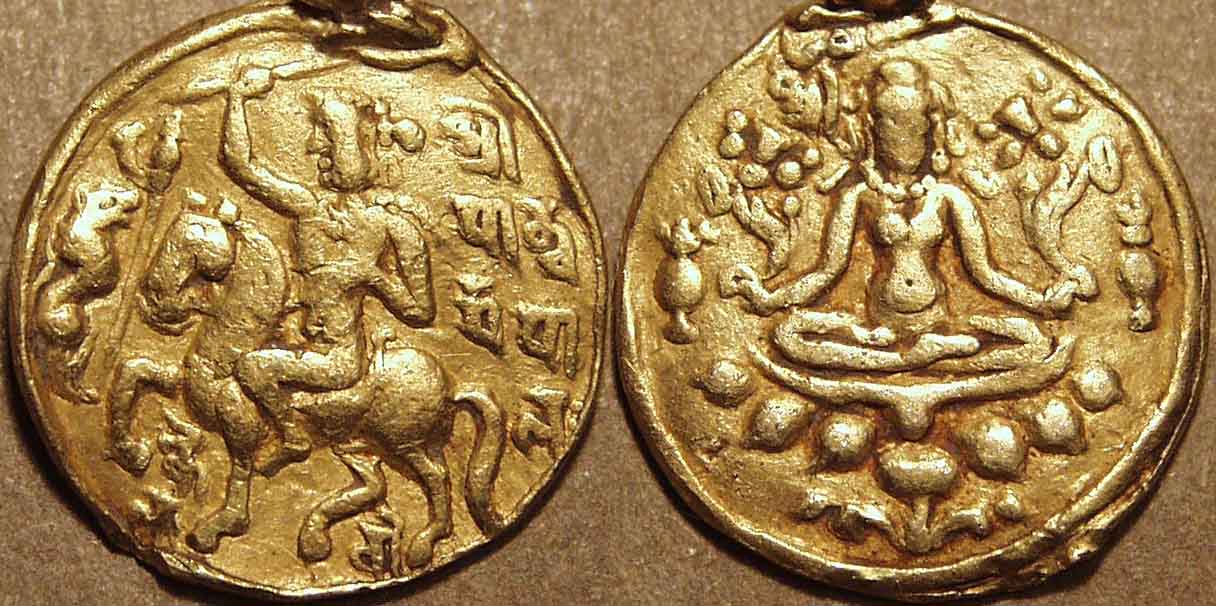
|
Coin #25:
Pala Empire, Dharmapala, Gold dinar, c. 775-810 CE
King on horsebak left, brandishing spear at animal at left,
Brahmi legend: sriman dharmapalah kailavo /
Lakshmi seated facing on lotus in padmasana, holding lotus in each hand,
Brahmi sri at top left
Weight: 7.59 gm., Diam: 21 mm.
Ref: Tandon, NC 2006 |
|
Coin 25 is the first and only known coin of the great Pala king Dharmapala. The Palas were a major dynasty who ruled Bengal and a large part of the surrounding
country from the 8th through the 11th centuries. Through much of this period, they were locked in a fierce struggle for the control of the Indian heartland, represented
by the city of Kanauj in what is now Uttar Pradesh, with two other kingdoms, the Rashtrakutas of Maharashtra and Karnataka (builders of the temple at Ellora and the
famous Elephanta Cave temple near Mumbai) and the Pratiharas of Gujarat. See this map on
Wikipedia illustrating this struggle.
Dharmapala defeated these two rivals and installed his proxy on the throne in Kanauj.
The coin is in the style of late Gupta and post-Gupta coinage from Bengal. It shows the king mounted on a horse left, brandishing a spear at an animal at left. The
legend at right identifies the issuer: Sriman Dharmapala. The reverse shows the goddess Lakshmi seated on a lotus, holding a long-stemmed lotus flower in
each hand, and flanked by sacred vessels.
One very interesting aspect of this coin is the animal at the left on the obverse. At first blush, one would assume it is a lion, as the theme of the lion-slaying king was a
standard Gupta theme (see coin 18 above). However, the snout of the animal is not very lion-like at all; rather, it looks more like a boar's. I would like to suggest the
possibility that the animal is intentionally ambiguous and represents both a lion and a boar. The lion was the dynastic symbol of the Rashtrakutas and the boar was the
dynastic symbol of the Pratiharas. I believe the coin may have been a propaganda piece: it could have been meant to show Dharmapala as the conqueror of both his
major enemies.
To see the approximate geographical location of where this coin was issued, look for the letter G on this map. To read more about
the importance of this coin, see my paper on it, published in Nummismatic Chronicle, 2006.
|
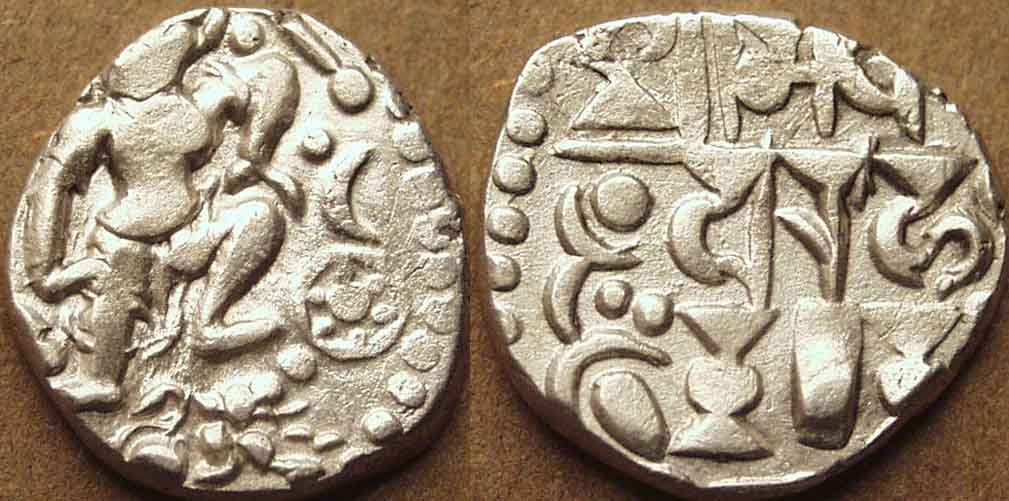
|
Coin #26:
Gurjara Pratiharas, Bhoja I, Silver or billon drachm, c. 9th century CE
King Bhoja standing triumphant right, foot resting on lion below,
Various Vaishnavite symbols at right /
Two-line legend: srimad adi / varaha,
symbols below
Weight: 4.03 gm., Diam: 17-18 mm.
Ref: Mitchiner Non-Islamic 335 |
|
Coin 26 is a very interesting companion to the previous coin. It is a silver drachm issued by the Pratihara king Bhoja I (836-885), who chose for himself the name Adivaraha,
which was also a name of Lord Vishnu. The front of the coin features an image that appears to be Lord Vishnu in his form as the boar Adivaraha. The style and pose
closely parallel an image of Adivaraha at the 6th century Gupta site of Udaigiri, in which the great boar is shown trampling the demon Naga
as he rescues the goddess Ganga, and with her the world.
Most coins of this type do not show the creature under Adivaraha's foot, as it is typically off the flan. But this coin clearly shows the animal to be a lion. However, the myth
of Adivaraha does not include a lion. Therefore, the figure on the coin must not actually be Adivaraha. It must represent Bhoja himself. A natural question to ask is, what
does the lion represent? It may have been Wilfried Pieper who first suggested that the lion represents the Rashtrakutas, a dynasty whose symbol was the lion and with which
Bhoja was in a constant struggle for supremacy. The coin therefore is another masterly piece of propaganda, in which Bhoja identifies himself as the savior of the world,
Adivaraha, as he crushes his demon enemies, the Rashtrakutas, underfoot.
This coin was featured on the cover of the August 2010 issue of The Celator.To see the approximate geographical location of where this coin was issued, look for
the letter D on this map.
|
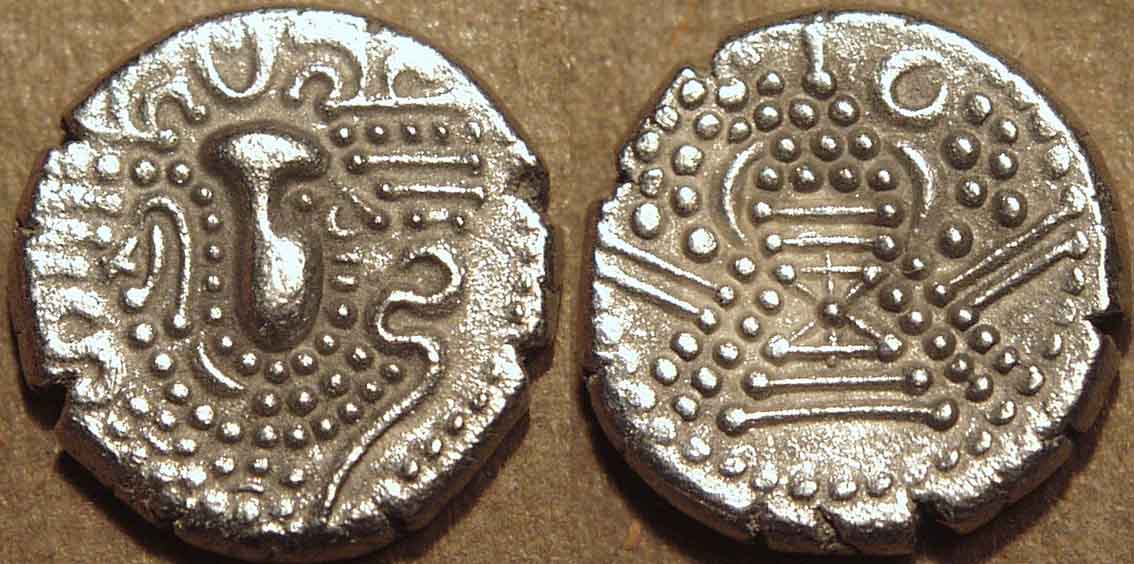
|
Coin #27:
Chalukyas of Gujarat, Anonymous Silver or billon drachm, c. 10th-12th centuries CE
Stylized head right /
Stylized fire altar
Weight: 3.97 gm., Diam: 16 mm.
Ref: Deyell 156-159 |
|
During the 9th and 10th centuries, the kingdoms of Western India, including the Chavadas and Chalukyas, issued large numbers of silver coins modeled on Sasanian
prototypes. These coins featured a king's head right on the obverse and a stylized fire altar on the reverse. Over time, the bust and the fire altar became more and more
stylized. Coin 27 is an example of this coinage, where the bust is still quite recognizable, but the fire altar has become a series of dots and lines at various angles. These
coins are normally referred to as "Gadhaiya" paisas, although nobody seems to know how they came by this name. The coins our often quite worn, but this is a very nice
example.
To see the approximate geographical location of where this coin was issued, look for the letter D on this map.
|
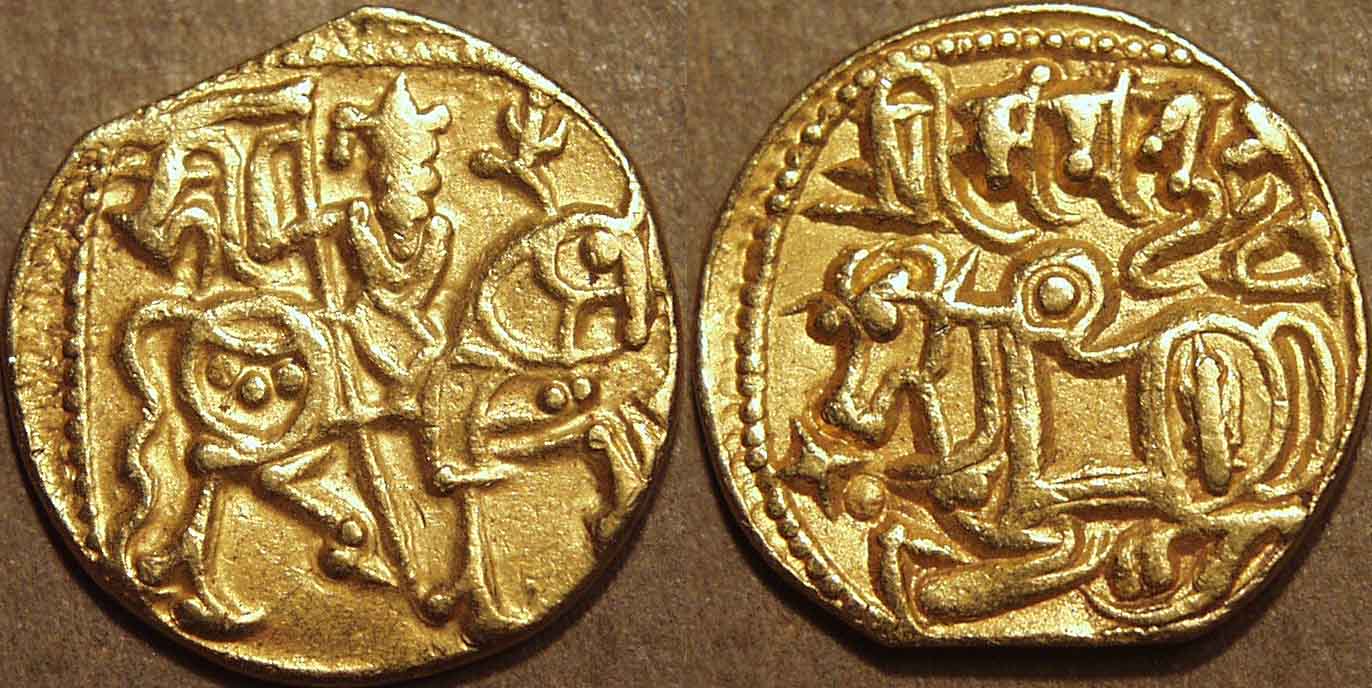
|
Coin #28:
Hindu Shahis of Kabul, Samanta Deva, Gold dinar, c. 10th century CE
King mounted right /
Recumbent bull left, Nagari legend above: sri samanta deva
Weight: 7.45 gm., Diam: 20 mm.
Ref: --- |
|
Coin 28 is, I believe, a unique and previously unpublished gold coin of the King Samanta Deva, a member of the last Hindu dynasty to rule in what is now Afghanistan, the
Hindu Shahis of Kabul. The silver coins of this ruler are quite common, but, as far as I know, this is the only known gold coin of the type. It shows the King mounted right and
holding a standard on the obverse, and a couchant bull left topped by the legend Sri Samanta Deva on the reverse.
To see the approximate geographical location of where this coin was issued, look for the letter A on this map.
After I first posted this coin, there was a spirited discussion about it on the South Asia Coins Group.
(If you are not a member of the SACG, and are interested in Indian coins, you should definitely join.) The upshot of this discussion is that it appears this coin is a very well
made forgery ... a fantasy gold version of the well-known silver drachms of this type.
|
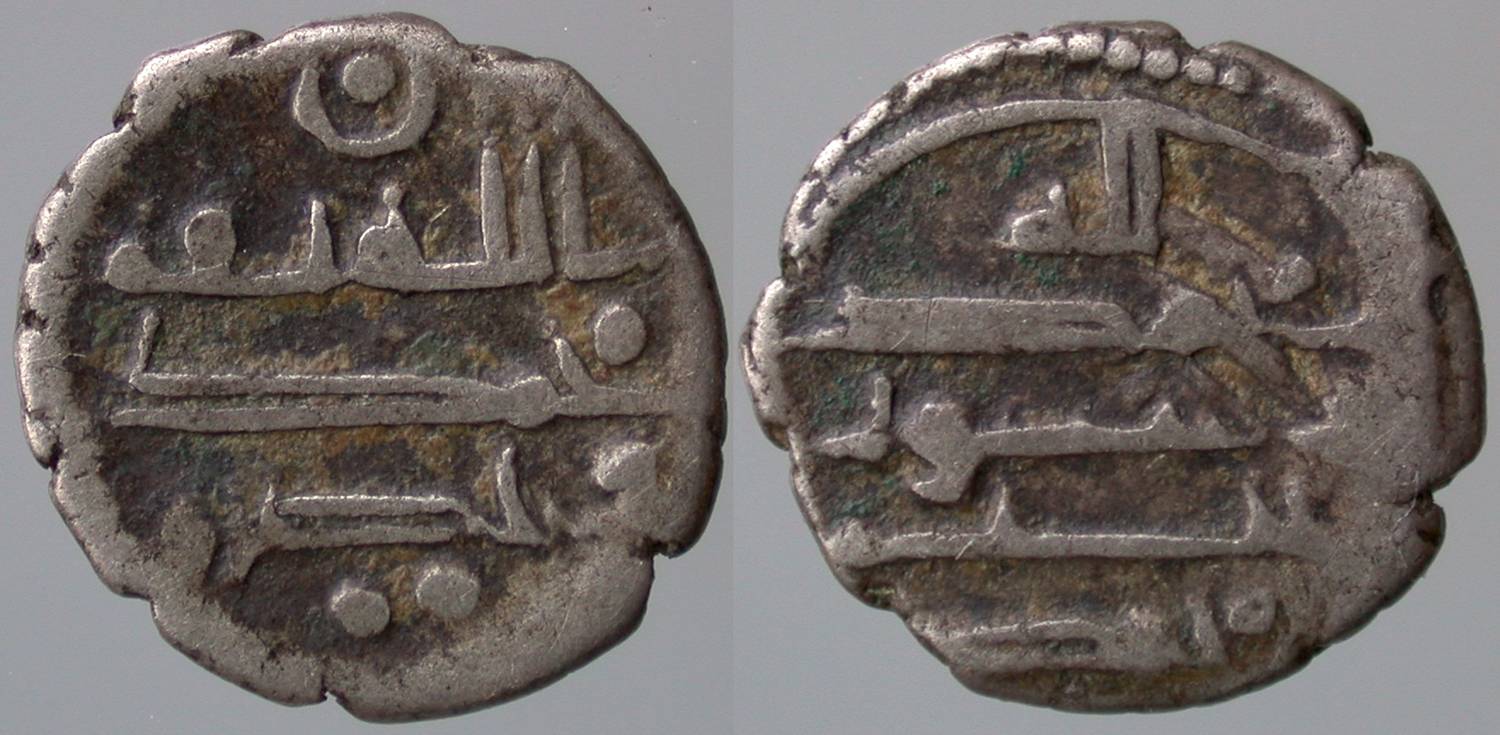
|
Coin #29:
Habbarids (Amirs of Sind), Nasir al-din Muhammad, Silver damma, c. 10th century CE
Legend /
Legend
| |
Of course the Hindu Shahis were the last Hindu rulers in Afghanistan because much of northern India came under the rule of the Muslims. Islamic invaders first arrived in the
province of Sind (what is now southern Pakistan) at the command of the Caliph in Baghdad in the eighth century, but it seems that they did not issue coins right away.
Indeed, they do not seem to have consolidated their position very well and their power was tenuous at best. It was only in the ninth century that Muslim rule became more
firmly established and the Amirate of Sind was created.
Coin 29 (photo courtesy of Jan Lingen) is a 10th-century issue of one of the Muslim Amirs of Sind and one of the earliest Islamic coins of India. What is most notable
about this coin is that it does not have any kind of image on it. Rather, it features an Islamic legend on both sides. The strict Islamic admonition against images of any kind
resulted in a coinage that almost invariably consisted only of legends. The legends were typically phrases from the Koran in praise of God. The style of this coin closely
matches that of contemporary coins from Iraq, from where the invaders had come.
To see the approximate geographical location of where this coin was issued, look for the letter E on this map.
|
|
|








